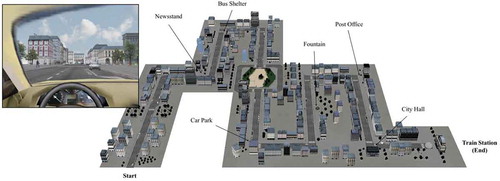Figures & data
Table 1. Sample characteristics.
Figure 1. Illustration of the virtual environment including a view from the virtual driving seat during the experiment (left) and a map of the city (right) showing the location of the prospective cues.

Figure 2. Recall of each component (prospective vs. retrospective) for each type of intentions (Link-EB vs. NoLink-EB vs. TB) among the young (left) and older (right) groups. * p < .05. ** p < .01. *** p < .001. Age effects highlighted on all PM measures are not depicted.

Table 2. Young and older groups’ performances (mean ± standard deviation) on the complementary cognitive assessment.
Table 3. Forward stepwise regressions on the different PM scores with complementary neuropsychological scores as predictors for the whole sample.
Figure 3. Mediation of the effect of ageing on prospective memory for (1) Link-EBPM intentions, (2) NoLink-EBPM intentions, (3) TBPM intentions, (4) the prospective component (ProCom), and (5) the retrospective component (RetCom). Coefficients correspond to the beta weights. ns = nonsignificant. * p < .05. ** p < .01. *** p < .001.

Table A1. List of intentions.
Table A2. Two-sample t-tests for participants’ performance in post-test free and cued recalls of intentions.
